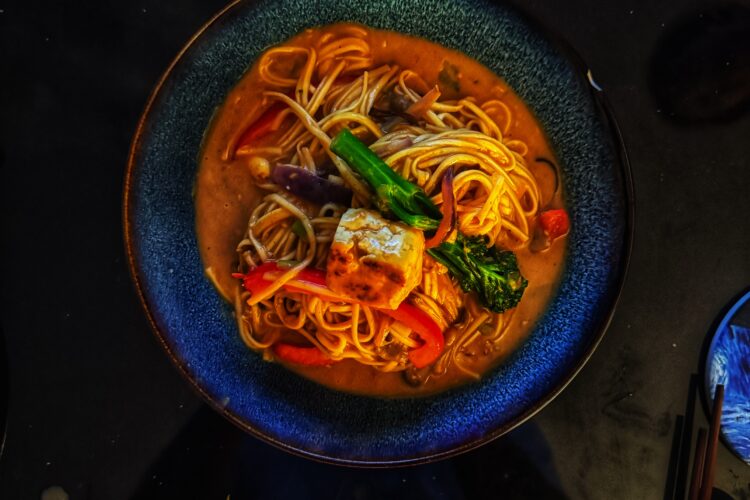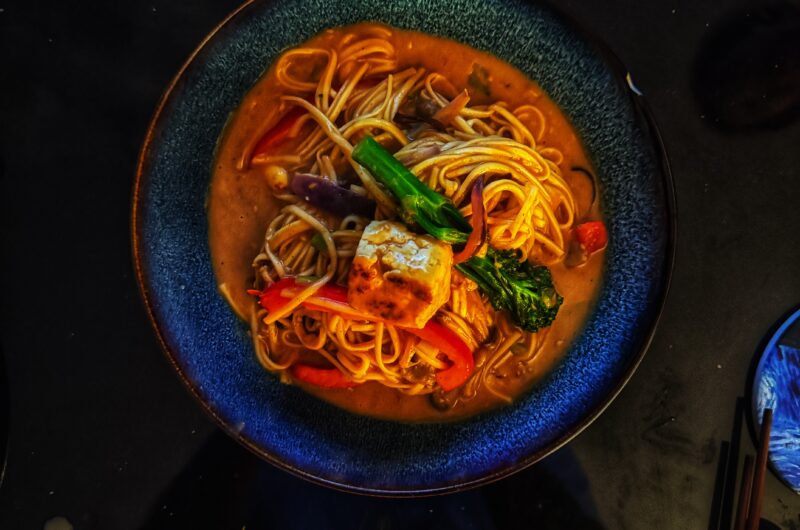A warming bowl of ramen is more than just food; it’s comfort, nourishment, and a hug in a bowl
Ramen has been a favourite around the world for the longest time. Whether it is instant ramen from the supermarket or a comforting bowl from the local Japanese restaurant, ramens have won the heart of almost everyone around the world. The flavourful broth, the chewy noodles and the medley of toppings, all come together to form a deeply satisfying and family-friendly meal, perfect on chilly evenings.
For me, finding a good vegetarian ramen has always been a challenge. I have enjoyed this delicacy only a handful of times at rare fine-dining restaurants. That changed when I moved to the UK. I craved the comfort of soupy, well-made noodles on the long and chilly evenings. I started experimenting with simple broths, varying spice levels and different flavourings.
Soon, inspired by the ramen at quick service restaurants like Shoryu and much quainter places like Itadakizen near St. Pancras, I decided to stay true to Japanese flavours. I read, I watched, I tested and repeatd this process over and over again. Several attempts later, I developed my own recipe for that warming bowl of comfort.
So, how does this differ from the traditional ramen recipes?
I leave the real expertise to the ramen masters in Japan; ramen shop owners and moms! However, re-creating vegetarian and vegan versions of classic Japanese food has been a journey of discovery! Getting the savoury, marine-like, umami and rich flavours in a meat-free broth has been a feat. I brought out rich flavours using kombu, mushrooms and miso while I let the locally-sourced British toppings shine. This recipe is a blend of tradition and adaptation; making it a perfect meal for home cooks with a limited arsenal of exotic ingredients.
If you have your tweaks and suggestions that you think work better, I would love to hear them in the comments below.
When I first read that for a great ramen, getting the broth right is the key, I did not believe it. I wondered how such a simple, watery liquid could make any difference at all. However, as I tasted ramen over the years, I realised how a deep broth made using Japanese techniques could entirely change the dish. Therefore this ramen starts with a dashi broth, filled with umami flavours from kelp (kombu), shiitake mushrooms and miso paste.
I love getting my Asian groceries from Tian Tian. However, the local Asian grocery in your area might be just as great! Once you are a regular buyer, you will start noticing brands you like: however, this kombu is my favourite. I usually end up buying my Japanese soy sauce and Miso paste when I do my weekly shooping at Waitrose.
Step 1: Make the Broth
- Soak a piece of kombu in 1.2 liters of water in a pot. This will form the base of your broth. If you prefer a thinner soup, you can always add extra water later. If you do not find kombu, you can alternatively use kombu stock powder or kelp powder. If you are using this, you can skip soaking it in water.
- Start heating the pot of water over low heat, keeping the kombu in the water. Add chopped shiitake mushroom stems, 2 tbsp veggie stock powder and 1 teaspoon of dried mushroom powder (optional, but highly recommended for a deeper umami flavor).
- Stir in 2 teaspoons of freshly grated ginger, then bring the water to a gentle boil over very low heat. Let it simmer for 30 minutes to 1 hour to extract all the flavors.
- Strain the broth through a fine mesh sieve. Your Japanese-style ramen broth is now ready!
💡 Storage Tip: Let the broth cool before storing. It keeps in the refrigerator for up to a week or can be frozen for up to 2 months.
Step 2: Build the Soup
- Return the strained broth to the pot over low heat. Add:
- 1 cup of soy milk (or skimmed dairy milk for a non-vegan option)
- 1 tablespoon of sake (optional)
- 2 teaspoons of mirin
- 2 teaspoons of Japanese soy sauce (sweeter and more complex than Chinese soy sauce)
- Adjust the consistency by adding more water if needed. If adding water, let the broth simmer for another 5 minutes.
- Remove the pot from heat and whisk in 1 tablespoon of miso paste until fully dissolved.
✨ Your ramen soup base is now complete!
Step 3: Prepare the Toppings
Customize your bowl with fresh vegetables and tofu. Here’s how I prepare mine:
- Baby Pak Choi: Steam or boil in salted water for 2–3 minutes until tender.
- Mung Bean Sprouts: Use the same salted boiling water to blanch for 1–2 minutes. This will leave the bean sprouts with a slight crunch. Reserve the water to boil the tofu in it.
- Spring Onions & Mushrooms:
- Heat a pan with a little oil.
- Sauté the spring onions until translucent.
- Add mushrooms and cook until they release their moisture.
- Tofu:
- Boil firm tofu in salted water for 5 minutes until the exterior looks slightly shriveled. You can use the same water that you used to blanch the baby pak choi and mung bean sprouts.
- Drain and pat dry using a kitchen towel.
- For crispy tofu: Stir-fry until golden brown. I prefer mine soft and lightly salted, but crispy tofu makes a great katsu-style addition.
Step 4: Cook the Noodles
- Cook your ramen noodles according to the package instructions.
- Divide the noodles into two serving bowls.
Step 5: Assemble Your Ramen

- Pour the steaming hot broth over the noodles.
- Arrange the toppings: boiled tofu, blanched pak choi, mung bean sprouts, and sautéed mushrooms with spring onions.
- Garnish with:
- Japanese 7-spice (optional)
- Fried onions
- Thinly sliced ginger (optional)
- Spring onion greens
Grab your chopsticks, mix it all up, and enjoy your homemade vegan ramen! 🍜✨
Warming Ramen bowl: A mildly spiced delight
Course: Main, One-potCuisine: JapaneseDifficulty: Medium2
servings10
minutes30
minutes320
kcal2
hoursIngredients
- For the ramen soup
1.2 l water
25 sqcm kombu or 3 tsp kombu stock powder
1 tsp dried mushroom powder
Mushroom stems, chopped from the shiitake mushrooms
2 tbsp veggie stock powder
250 ml unsweetened soy milk (or substitute with skimmed milk)
1 tbsp sake
2 tsp mirin
2 tsp Japanese soy sauce (or substitute with Chinese soy sauce and 1/2 tsp brown sugar)
1 tbsp miso paste
- For the toppings and noodles
160 g dried ramen noodles (or serving seize for 2 as recommended on the pack)
100-120 g tofu
250 g shiitake mushrooms
70 g mung bean sprouts
1 bunch spring onions (6-7 onion heads), sliced
80 g baby pak choi
- For garnishing
2 tbsp fried onions
3 tbsp spring onion greens, chopped in 45 degree angles
1 tsp Japanese 7-spice (optional)
1 tbsp ginger, thinly sliced (optional)
Directions
- Making the ramen soup
- Soak the kombu in water for 20-30 minutes. Now bring the water to a boil with the kombu in it.
- Add mushroom powder, veggie broth powder, stems of the chopped shiitake mushrooms and grated ginger. Simmer on a low flame for 1 hour.
- Strain the broth using a fine mesh sieve. The liquid is your broth.
- Transfer the broth to the pan again and simmer on a low flame. Add milk (or soy milk), sake and mirin to the broth. Check the consistency and add up to a cup of water if you prefer a soupier consistency. Let this simmer for 5-10 minutes.
- Take the soup off the flame and mix in 1 tbsp of miso paste. Your ramen soup base is now ready.
- Preparing the toppings and the noodles
- Take 160 g of noodles and cook it in boiling water and salt for 5 minutes (or as per the instructions on the pack). Strain the noodles and set it aside.
- Blanch the baby pak choi in boiling salted water for 2-3 minutes. Remove the pak choi and blanch mung bean sprouts for 1-2 minutes. Remove the mung bean sprouts and retain the water.
- Use the same boiling salted water to boil the cubed tofu for 5 minutes.
- Now, take a pan, heat olive oil (or any other neutral oil) and sauté the sliced spring onions. Once the onions turn translucent, add the shiitake mushrooms and sauté till the mushrooms release all the water and brown slightly.
- Assembling, garnishing and serving
- Divide the noodles into 2 bowls.
- Add equal servings of the ramen soup in both bowls.
- Top with pak choi, sautéed mushrooms and onions, tofu and mung bean sprouts.
- Garnish with fried onions, 1/2 tsp Japanese 7-spice (optional), chopped spring onion greens and sliced ginger (optional).
- Serve immediately as it is best enjoyed steaming hot.
Notes
- While the entire ramen cannot be stored well, the broth is perfect for storing. Store in an airtight container for up to a week in the refrigerator. You can also freeze it in ice cube trays or in an airtight container for up to 2 months.
If you don’t have an Asian store nearby, I recommend you check out out my simple ramen recipe here. It uses a salt and veggie broth and is packed with Japanese flavours, despite its use of highly accessible ingredients.
If you loved this recipe, do try it out at home this weekend and let me know your thoughts in the comments below!


